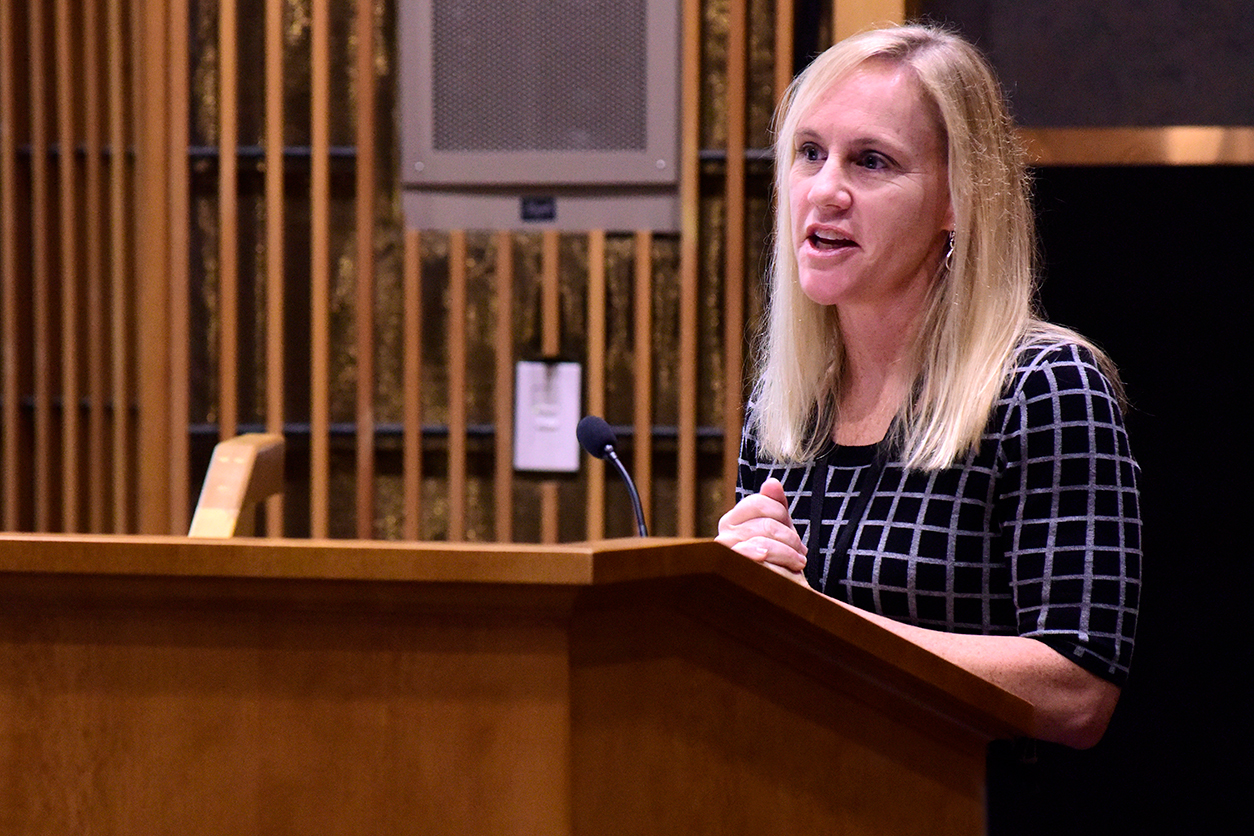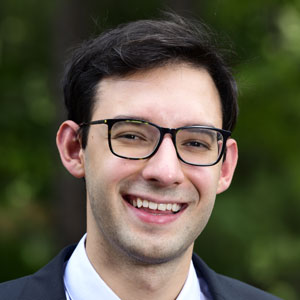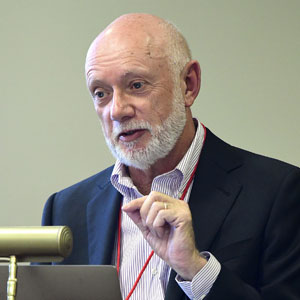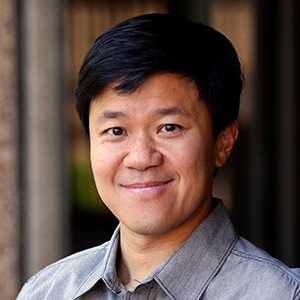
For this month's column, I had the pleasure of sitting down with Dr. Heather Patisaul, who will take the reins as the new Scientific Director of the NIEHS Division of Translational Toxicology (DTT) on March 24. Our conversation delved into her aspirations for the division, her vision for advancing toxicology, and the innovative scientific and leadership approaches she will promote.
Dr. Patisaul is a distinguished neuroendocrinologist from North Carolina State University, where she has served as associate dean for research in the College of Sciences. She has led a laboratory focused on the health effects of endocrine disruptors, exploring how these compounds alter neuroendocrine pathways and how such changes can vary by sex.
Her appointment marks a pivotal moment for NIEHS, reflecting our ongoing commitment to advance environmental health science through cutting-edge research and strategic collaborations. I believe that Dr. Patisaul’s scientific expertise and leadership skills will steer DTT toward exciting horizons, helping to address critical health challenges and research gaps.
As we welcome Dr. Patisaul to her new role, I invite you to join me in exploring her goals for DTT, her strategies for fostering scientific excellence, and her insights on the vital role of translational toxicology in improving public health outcomes. She also shared her own scientific interests and discussed what inspired her to become a researcher.
The environment and brain development
Rick Woychik: You are internationally recognized for your groundbreaking research into how endocrine disruptors can affect brain development. Can you talk more about that?

Heather Patisaul: Sure. I have always been interested in how the brain forms and shapes during development, why male and female brains are different, and what factors influence brain development, whether positively or negatively. So, I am broadly interested in all of that, and my research focuses on environmental influences on the developing brain.
In my graduate work, I began by studying lemurs, and we tried to understand how environmental factors — such as soy phytoestrogens, which are naturally occurring compounds — can influence breeding season and breeding success. Later, I began to use rodent models to better understand how exposures can affect key biological mechanisms. I looked more at manmade chemicals, such as bisphenol A [BPA], and the team I led now works a lot with different flame retardants.
Collaboration sheds light on BPA
RW: Very interesting. Can you expand on your BPA work?
HP: Yes, we started looking at BPA, which is an estrogenic endocrine disruptor, because we wanted to figure out specifically what it was doing in the brain. We have shown in a variety of rodent species that exposure can advance female puberty, disrupt the development of circuits that control ovulation, and affect parts of the brain that control sex-specific behaviors.
One of the most exciting projects we worked on is the Consortium Linking Academic and Regulatory Insights on the Toxicity of Bisphenol A, also known as CLARITY-BPA. That was a collaboration involving NIEHS, the National Toxicology Program, the U.S. Food and Drug Administration, and academic scientists, including our group at NC State.
Through those studies involving rodent models, we found that exposure to BPA changes the amount of estrogen receptors in the brain and the size of some sexually dimorphic brain areas, which we believe contributes to changes in behavior.
Forging partnerships key to success
RW: What are you most excited about as you prepare to take the helm of DTT?
HP: I am excited about working in DTT because it is a hub of amazing researchers doing top-tier science as a group, and they often collaborate across disciplines, fields, and platforms. I am a strong proponent of collaborative research and team science because in my view, that is the only way we can tackle some of our grand challenges, including how to gather toxicity data on the hundreds of thousands of chemicals out there in our world. We have to strategize better about how to do that more effectively, and it will take a cross-disciplinary approach to be successful.
For me, translational toxicology is all about developing ways to turn research data into human-relevant knowledge that can inform decision-making at the individual and population levels. As part of that work, we need to understand the needs of regulators, policymakers, and others so that we can provide them with the highest quality science to advance public health. DTT’s work is a form of preventive medicine because that is the ultimate goal — preventing disease. So, building collaborative relationships with other agencies, scientific organizations, and academic researchers is critical.

Expanding the toxicological toolkit
RW: What are some of your other goals for DTT?
HP: Our research should continue to be predictive, reliable, and aimed at yielding greater insights into environmental contributors to disease. For example, I often think about how to align developmental neurotoxicity testing with actual neurodevelopmental disorders that we worry about, such as autism and ADHD [attention deficit hyperactivity disorder]. Those disorders are all defined behaviorally, which can be a challenge for classic toxicological approaches, which look more for pathological changes. We have to get more comfortable at working to understand different hallmarks in the brain that can shed light on disease.
Beyond neurotoxicity testing, innovation in toxicology more broadly will require working in traditional models but also branching out to develop and use computational tools and things like new approach methodologies [NAMs], which I believe are the future of toxicology. NAMs are emerging tools and approaches — such as artificial intelligence, machine learning, and cell-based systems, to name a few — that promise to complement traditional animal models.
Another opportunity area is systematic review, which involves synthesizing existing data and research on a given exposure. For example, there is plenty of data on BPA, but how can the scientific community better integrate it? How are we going to decide what studies are high quality? Systematic review, which DTT does very well, can help us address these questions.
Effective training and mentorship are also essential. I believe DTT can be a hub through which we educate early-career scientists on how to do translational toxicology. Going from generating data in a lab to translating it into useful knowledge is difficult, and I think our division can serve as a model for how to do that kind of research. I want us to build a vibrant training program.
Prairie voles offer insights
RW: Previously, you have noted that before researchers begin to address a scientific question, they need to first ask what is the right tool or set of tools that they should use. In some cases, that may be NAMs, and in other situations that may involve traditional approaches or even something like prairie voles as a model system. Can you provide an example of what you mean?
HP: Absolutely. In some of my team’s previous research looking at environmental influences on brain development, we incorporated prairie voles. They are unique because they are socially monogamous animals, so the male and female bond for life. Neuroscience, dating back decades, has used this species to understand the evolution of sociality and to understand the neuroendocrinology of social behavior. So, they are a well-established research model in the neuroscience community.
I adopted them to ask toxicological questions about whether there are chemicals that can disrupt systems and circuits that underlie attachment. In our work on flame retardants, we do see disruptions in these social circuits. Our goal is to try to understand how the social brain might be at risk due to some of these exposures, and prairie voles are a great way to do that because they show pair bonding. The dads show paternal care, whereas rats and mice do not. And the siblings also help raise the newborns, and rats and mice do not. These animals show a lot of key behaviors that are seen in humans but not in rats and mice.
So, I am a big believer in asking what is the right tool to address a specific scientific question. Sometimes, that may require us to try different approaches or to branch out of our comfort zone, but doing so will lead to higher-quality science and greater innovation, in my view.
Inclusive culture spurs innovation
RW: Any final thoughts that you would like to share with our readers?
HP: I want to foster an inclusive culture at DTT. Do people feel excited to come to work? Do people feel valued and that their ideas are cherished? I want an atmosphere of open dialogue so that we can be as innovative as possible in how we work and how we collaborate. Our goal should be to attract the best people to be part of that culture so that they want to bring their differences, ideas, and unique experiences to the table. I am honored to join DTT, and I am excited to hit the ground running.
(Rick Woychik, Ph.D., directs NIEHS and the National Toxicology Program.)









